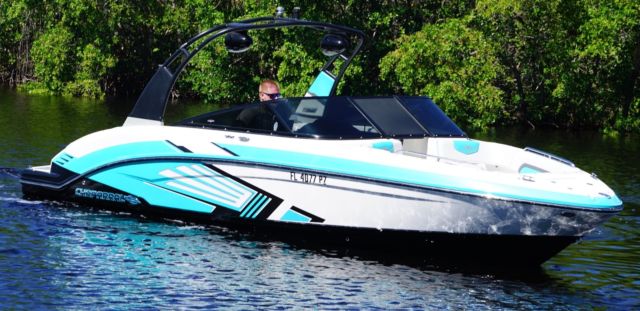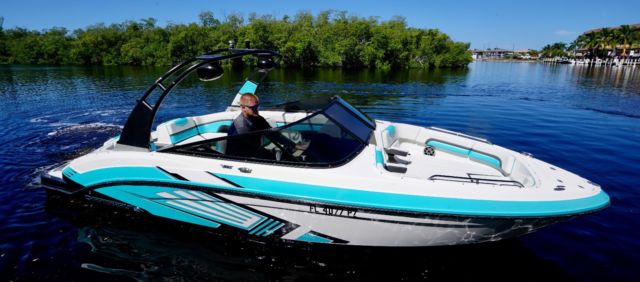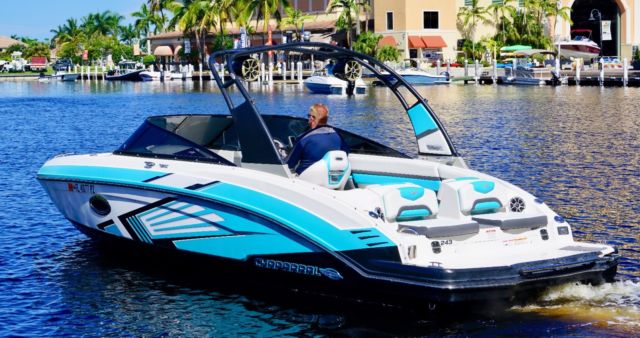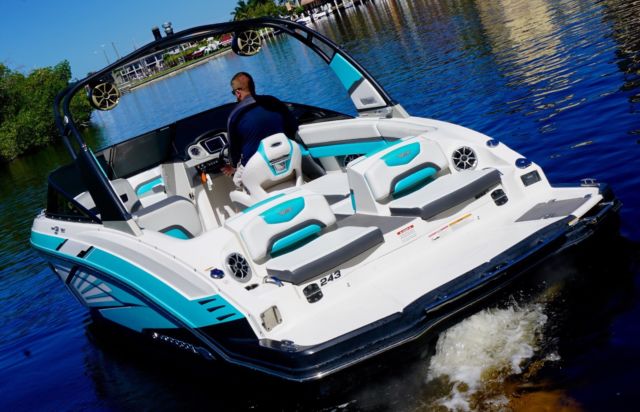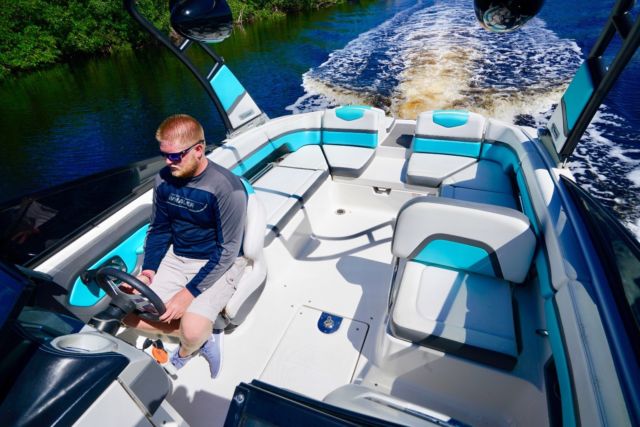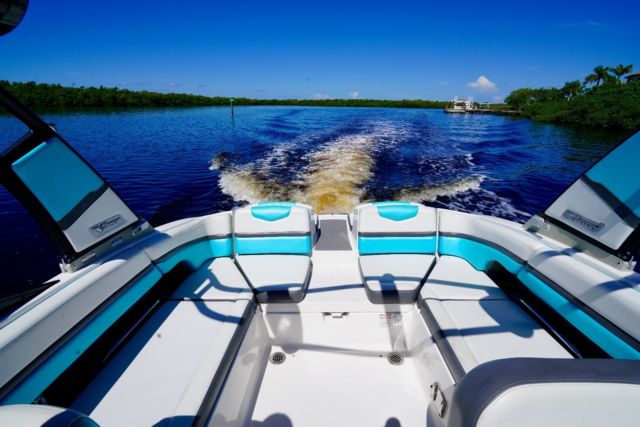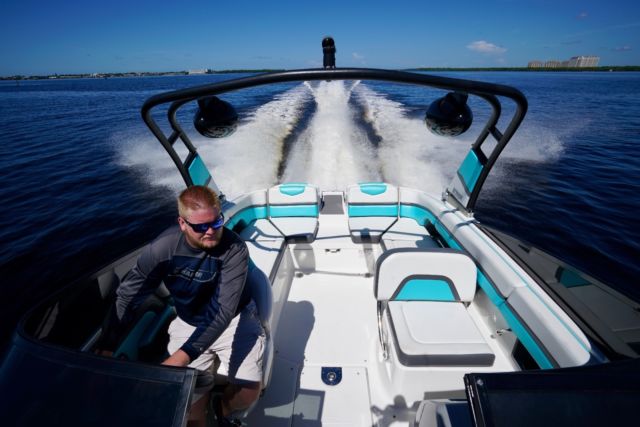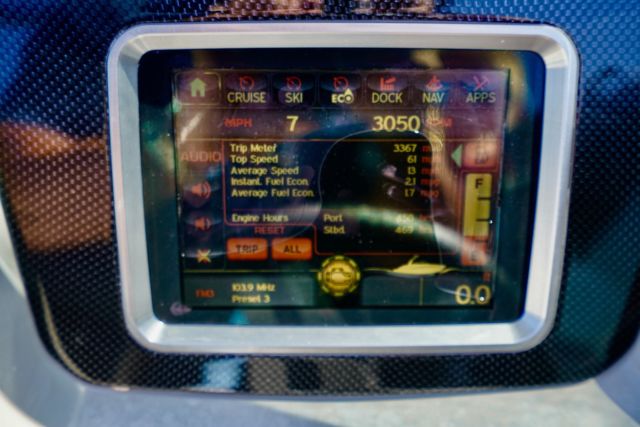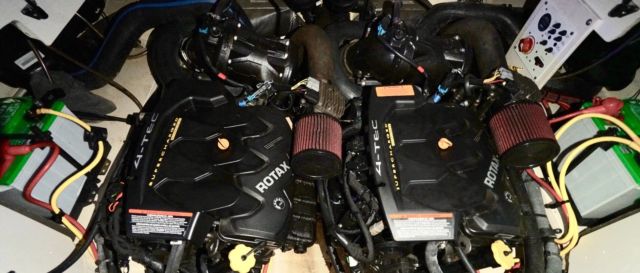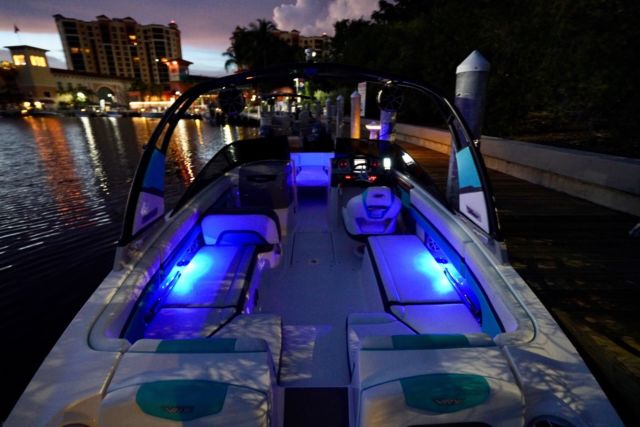You are bidding on a 2016 Chaparral 243 Vortex with 450 hours of use! twin Rotax jet drive 4-Stoke engines this 243 has an amazing top speed of almost 55 MPH! The boat was lift kept behind a house locally here in Cape Coral, and it does not have a trailer. A new trailer can be purchased for the price of $3,995.00 with custom mag wheels to match.
Brief Summary With the introduction of its 243 VRX, Chaparral now has six jet boats in its lineup ranging from 20’ to 24’ (6.10 m to 7.31 m). This largest version is naturally our favorite as she’s not only the roomiest of the series, but her size lends her to longer trips while straying from landlocked or protected waters. Her Chaparral DNA means that she takes waves with the same agility as the sterndrive and outboard models. At the dock, she’s extraordinarily maneuverable.
Key Features - Capacity for 12 people
- The Medallion touchscreen
- Reversible observer's seat
- Cockpit pedestal table
- Twin V-seats in bow
- Built-in self-draining cooler
- Forward hatch with anchor and reboarding ladder
- Color-matched padded sport arch
- Towpoint with mount for a Go-Pro camera, viewable on the helm video screen
Specifications Length Overall 24' 3''
7.39 m |
Beam 8' 6''
2.59 m |
Dry Weight 3,600 lbs.
1,633 kg |
Tested Weight 4,254 lbs.
1,929 kg |
Draft 13''
33 cm |
- Draft Up | N/A |
- Draft Down | N/A |
- Air Draft | N/A |
Deadrise/Transom | 20-deg. |
Max Headroom | open |
Bridge Clearance 7' 7''
2.31 m |
Weight Capacity | N/A |
Person Capacity | N/A |
Fuel Capacity 60 gal.
227 L |
Water Capacity | N/A |
Length on Trailer | N/A |
Height on Trailer | N/A |
Trailer Weight | N/A |
Total Weight
(Trailer, Boat, & Engine) N/A |
Prices, features, designs, and equipment are subject to change. Please see your local dealer or visit the builder's website for the latest information available on this boat model.
Engine Options Std. Power | Not Available |
Tested Power | 2 x 250-hp Rotax 4-TEC 250 |
Opt. Power 2 x 200-hp Rotax 4-TEC 200 ECT
2 x 250-hp Rotax 4-TEC 250 ECT |
Test Results - Change Measurement Unit All fuel consumption numbers are the total for all engines in the boat. Speeds are measured with Stalker ProSports radar gun or GPS. Fuel consumption (gallons per hour) measured with Floscan digital fuel-flow meter or by on-board factory-installed diagnostic instruments. Range is based on 90% of published fuel capacity. Sound levels determined using Radio Shack digital decibel meter on A scale. 68 dBA is the level of normal conversation. Time to plane is measured from start of acceleration to formation of rooster tail behind boat.
Performance Chart Acceleration Times & Test Conditions Time To Plane | 2.0 sec. |
0 to 30 | 5.8 sec. |
Ratio | N/A |
Props | 161mm impellers |
Load | 2 persons, 13/20 fuel, no water, 50 lbs. of gear |
Climate | 85 deg., 80 humid.; wind: 0-5 mph; seas: flat |
Mission Statement It’s no surprise that several manufacturers are jumping on the jet boat bandwagon. Chaparral has introduced six new models with the 243 VRX now being the largest. She has a larger capacity than most in this size range and can comfortably hold 12 people, but of course that only means that everyone has a seat. More realistically, it also means that for a typical load of between 4 to 7 people there will be more room to move about, making this an excellent platform for entertaining friends.
With wraparound seating the 243 VRX can easily accommodate 12 people.
But there’s more to the 243 VRX’s story than just capacity. Chaparral also had two other goals for the design team. One of which was to maintain the trademark Chaparral DNA with regards to both exterior styling and hull design. Check and check… this boat totally looks like a Chaparral to even the most casual observer with her high freeboard, sweeping sheerline and stainless rubrail sloping down to join the integrated swim platform. She’s also pure Chaparral under the waterline and performs just as well as the other boats in the company’s sportboat lineup.The third goal was to remove the stereotype that jet boats are hard to handle around the dock. With her clever “lateral thrust control†we found that controllability around, and away, from the dock was unprecedented for a jet boat. But we’ll get more into that in a moment.
Distinguishing Features Available in Two Versions. The 243 is available in either the VR or the VRX version. The VR is the more “tame†graphics available in Black, Blue, and Red and comes standard with a Bimini top, folding tower is optional. VRX is the sportier graphics and colors (Blue, Gray, Red, Lime Green, Aqua, and Yellow). VRX is also standard with folding tower with built-in Bimini top and ski mirror.The latter adding enhanced watersports capabilities such as the sport arch and upgraded graphics.
Medallion Touchscreen with Rotax Speed-Control Functions. The standard 6.5†(16.5 cm) Medallion touchscreen makes it easier to access the Rotax control functions which adds precise control over maximum speed, towing parameters, fuel efficiency and a reduced power setting for docking. Additional features include a moving map display, digital depth and bottom scan readouts, control of the premium stereo system and fuel economy displays. App features allow, among many other things, being able to see video from Bluetooth Go-Pro cameras.
Kevlar Reinforced Hull. This provides the strength and solid feel to the Chaparral ride. It also allows Chaparral to stand behind its products with a 10-year limited hull warranty. Its premium hydropel resin is blister resistant.
Twin Engines, Single Control. The 243 VRX can be ordered with a pair of Rotax 4-TEC 200 ECT or a pair of Rotax 4-TEC 250 ECT engines, and both are controlled with a single lever at the helm.
Performance The 243 VRX has a LOA of 24’3†(7.39 m), a beam of 8’6" (2.59 m) and a draft of only 15†(38.1 cm). With 65% fuel and two people onboard we had an estimated test weight of 4,254 lbs. (1,930 kg).With the throttle fully forward we topped out at 54.3 mph with a 36.9 gph fuel burn. Best cruise came in at 5000 rpm and 25.4 mph. That produced a fuel burn of 8.8 gph, a range of 156 miles, and an endurance of just over 6 hours. All while still holding back a 10% reserve of fuel.Acceleration is brisk, as are the G-forces. She planes in 2 seconds, hits 20 mph in 3.9 seconds, and continues accelerating through 30 mph in 5.8 seconds.
Handling Whether at idle or high speeds, this is a well-mannered boat. The 243 VRX puts out enough low power thrust to track nice and straight at minimum speeds. Her lateral thrust control allows her to make idle speed turns in her own length, a convenient feature even away from the dock.At speed, she slices cleanly through waves with spray kept low and wide for a dry ride. She rolls only 10 degrees into the turns and carves well with no tendency to chine walk or even bleed off speed. However, in extreme turns she’ll spin out, as we expected. When taking power off she will settle back into the water from a level attitude and she’ll coast for a ways before doing so.It’s important to remember that there’s only steering when there’s thrust. Take away the power and the steering is also taken away. So let’s say there’s an object in front of the boat, something as mundane as a fish pot buoy. If an operator were to pull power off and turn away from the buoy, the boat will continue right towards it. Turn first, and then take power off if desired. This also applies to more serious obstacles such as a rock or swimmer, and it’s not just the 243 VRX that behaves this way, it’s the same with every jet boat on the market. All boats have their own handling characteristics, this is just the way it is with a jet drive.
The Rotax Difference Chaparral went with Rotax 4-TEC engines for the 243 VRX and owners can choose either a pair of 200 ECT or 250 ECT. We tested her with the Rotax 4-TEC 250 ECT engines and they, along with the rest of the Rotax line, have some distinct advantages. Most notably…lateral thrust control.
Twin Rotax engines provide the power for the 243 VRX and are available in two sizes. The silver components at the top are the catalytic converters. To the right is the battery switch, also accessed from the aft seat at the transom.
Lateral thrust steering is achieved by departing from the traditional method of attaching the thrust deflector bucket to the thrust nozzle. Here, the bucket is attached aft of the steering nozzle, and it’s more elongated, with open ends allowing the thrust to come out the sides when in neutral or reverse.
Here we can see the cutaway jet nozzle and the long bucket just behind with the openings at the sides. This directs the thrust out the sides, more so when the nozzle is steered.
This provides for some amazing maneuverability at the dock. She’ll easily pivot in her own length, and with some deft touches that we discussed in the docking section, the 243 VRX can practically dock with the agility of a pod drive boat.
Closed cooling is a feature that will appeal particularly to salt-water boaters. The running pad is actually a heat exchanger. A hose runs to the thermostat and water pump cooling the engine with the temperature reducing effects of having this pad underwater.
The ride plate will accommodate anti-freeze flowing through that will get cooled from the plate itself being underwater. Cooled anti-freeze then flows through the engine.
Shaft protection is achieved by enclosing the shaft in a stainless sleeve. Normally we have access ports allowing us to reach our hands down to the shaft to clear weeds. Here, the shaft is protected from ever getting fouled in the first place. Does the impeller get fouled? Sure, same as the competition. That gets cleared with a boost of power to send any weeds on their way. A grate over the intakes prevents larger objects from entering the flow to the thrust ducts. If those get clogged, typically all it takes is shutting down and letting gravity do its thing.
Here the shaft is protected by a stainless tube, seen here cut in half. Below is the cutaway of the grate keeping large objects out of the impeller.
Docking Now this is important as jet boats have an unusual characteristic that takes some getting used to. They steer backwards in reverse. This is totally opposite of what we’re all used to and will frustrate at first, but with a little practice it can be overcome quite easily. Here’s the trick…
For side-to docking , approach the dock straight on. Of course, before hitting the dock turn the wheel hard over, say to the left in this case. Now leave it there and shift into neutral. Rotax's lateral steering will allow the thrust to continue to steer her. Keep the thumb pressed on the shifter and now ease her gently from forward to reverse and she’ll not only come around, she’ll start to slide sideways to the dock. It may be necessary to take a little turn off the wheel, but this back and forth, in and out of forward and reverse, will serve the job well and it quickly becomes easy to control. When close enough, shut the engines off with the key and she’ll stop in position.That last part is important… shutting off the engines. With the engines running there’s always thrust so it will only end up pushing the boat out of position. Shut her down and she’ll sit (all things being equal, like wind and current).
For backing into a slip , use the same technique of shifting in and out of gear with the thumb held onto the shift release. But now, do not steer the stern. Because things are opposite it will mess with the approach. Instead, steer the bow. Want the stern to come left, steer the bow right and over she’ll come. It actually is quick to get the hang of and takes longer to write about than it is to learn it.But the simple fact is, this is a boat that will rarely see a dock. She’s a trailer boat through and through so really… don’t sweat the docking thing.
Features Inspection Helm Layout The helm is fabricated in gray tones that remove any concern for glare or adverse reflections in the windshield. A vinyl dash is stitched into place with contrast color stitching that is color matched to the hull scheme, in this instance, green UV resistant thread is contrasting the gray dash.
The 6.5†(16.5 cm) Medallion touchscreen eliminates the need for many of the usual gauges.Stitching throughout the 243 VRX is color contrasted to the material being stitched but matched to the color scheme of the boat.
This is a twin-engine boat with dual start/stop buttons just above the ignition key to the left of the helm. However, both engines are controlled from a single control at the helm. This means that there’s no putting one engine forward and the other in reverse to pivot the boat. The lateral thrust steering takes care of that nicely.
Twin engine start/stop buttons are just above the single ignition key.
Two gauges are recessed into molded placements to either side of the Medallion touchscreen display. By adding this screen, Chaparral removed the need for additional gauges, thereby cleaning up the panel considerably.
The Medallion touchscreen display has a lot to offer.
•
Cruise Mode – Allows for setting the desired cruise speed and maximum speed.
•
Ski Mode – Allows for a controlled launch with up to 5 pre-set acceleration curves and user defined target speed. Once underway, it accurately maintains tow speed with a GPS based controller.
•
Eco Mode – Optimizes engine efficiency by limiting engine torque.
•
Docking Mode – Re-scales the throttle for increased resolution and maneuverability at the dock.
•
Navigation Display – A moving map display comes pre-loaded with a Navionics SD card for the country of choice.
•
Apps Display – this provides setup displays, engine gauges, control of the premium stereo system and allows for a video display of Go-Pro cameras via Bluetooth.
•
Depth Readout – A display of the bottom depth as well as a contour scan are both available.
The captain gets a premium bucket seat and notice how Chaparral puts the adjustment levers for swivel and slide on the sides instead of hiding them under the seat like virtually all the rest of the industry. Cockpit Seating is something the 243 VRX has no shortage of. She can accommodate 12 people thanks to her U-shaped seating that wraps around the cockpit and the fact that the cockpit is brought out right to the hull sides for more room.
The port seat has a flip back to allow it to convert from forward facing to aft facing.
The observer seat is reversible by moving the seatback fore and aft. This allows it to serve as either a forward facing, or aft facing seat. Underneath the bench seats are storage to one side and a carry-on cooler to the other.
The addition of a pedestal table turns the cockpit into a great place for mid-day snacks or after cruise cocktails.
Bow The bow has the usual seating arrangement of twin V-seats with storage underneath. Looking closer shows how Chaparral goes a little further in its execution of the seating arrangement.The seats are hinged from the rear so there’s more access to the storage underneath. The vinyl is 38-millimeters thick with a 10-millimeter topcoat for added protection. All vinyl is stitched on with contrast colored thread color matched to the hull color scheme. Chaparral tells us that the multi-density foam is 40% thicker than the competition and there’s a mildew inhibitor inside. Speakers are recessed between cushions so they don’t hit against the back when sitting. Both the speaker grilles and the drink holders are stainless steel. Flip-up armrests are standard.
The roomy bow has plenty of open space to gather and relax.
Even the rails get a special treatment from Chaparral. They don’t have the typical round cross section. These are actually elongated so small fingers can wrap around them easier. It’s hardly noticeable, but it’s one of those “little things make a big difference†items, and it’s done in-house at Chaparral.
At the front of the bow is a built-in self-draining cooler. The stainless steel tab flips out to rest the filler cushion on.With the filler cushion in place, the bow becomes a large sun pad. Notice the blue LED courtesy light above the drink holder.
Stern The transom didn’t get left out of the seating consideration. A pair of doublewide aft-facing seats make a great place to relax anytime the 243 isn’t underway. It also forms a natural staging area for getting boards on before entering the water.
With the side-mount pedestal in place the stern becomes even more inviting.
The cushions lift to reveal space underneath that Chaparral says is additional storage, but we beg to differ.
Amenities Anchor/Ladder One of the things that Chaparral has managed to accomplish is finding a way to combine the anchor locker with an anchor and a reboarding ladder. In most cases, this is an either/or proposition but here they live together.
The 243 VRX has both an anchor and reboarding ladder under the forward hatch.
The hatch is held open with friction hinges, the anchor is held in position with keepers to both sides, the navigation light is flush mounted and reverses when in use and the bow is notched to accommodate the ladder and anchor rode. With the hatch closed, the non-skid treatment allows for a comfortable re-entry from the ladder and a launching off point for entering the water.
Sport Arch The sport arch is included in the VRX package and it’s a pretty classy setup. This one is powder-coated but the coating is textured so it’s got more of an ability to maintain a grip with wet hands. The sides of the arch, right at head-level from the seated positions, is padded… something we’ve not seen before.
The sport arch includes a padded area right at head level, and it’s color-matched to the boat’s color scheme.
The Bimini has the usual hardware running around the perimeter, but the tension supports, which are usually right over the heads of the operator and observer, are instead mounted to the center. In the middle of the Bimini is a padded area that eliminates flapping and reduces chafe. Lastly, the towpoint at the top has a mount to accommodate a Go-Pro camera and the video feed can be watched at the helm via Bluetooth.
Under the arch is a center tension bar and padding over the pipes. A pair of Wet Sounds speakers bring the music to the end of the towline.The towpoint includes a mount for a Go-Pro camera that can be viewed on the helm video screen.
Pricing The Chaparral 243 VRX comes in two versions…the VR for $55,595 and the sportier VRX that we tested for $59,995. That’s of course pricing with the base 200-hp engines and the trailer. The larger engines will add an additional $4,000 to the base price of each.
Options Of course there are always options and our test boat has some of the more popular, starting with the upgraded premium sound system ($1995). We also had the pumpout for the Porta-Potti ($505). These features and a few others, including the optional Medallion screen, brought the price of our tested version up to $67,845.
Observations It’s hard not to have fun in a boat like this. It was one of those tests where we just wanted to keep messing around in the 243 VRX and not have to bring her back. At the dock we turned heads not only because of the striking color scheme but because we were making her work so well with regards to the maneuverability.Of course, having the Chaparral name on the side only added to the bragging rights. This is a company well founded on building quality boats, and now that it has firmly established itself in the jet arena, that reputation will only grow.
Test Result Highlights - Top speed for the Chaparral 243 VRX (2015-) is 54.3 mph (87.4 kph), burning 36.9 gallons per hour (gph) or 139.67 liters per hour (lph).
 2010 Sea Doo 210 Wake Ski/Wake Boat 430 Horsepower Low Hours Great Condition
2010 Sea Doo 210 Wake Ski/Wake Boat 430 Horsepower Low Hours Great Condition
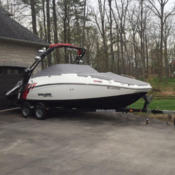 Sea Doo 230 Wake
Sea Doo 230 Wake
 2011 Sea-Doo 230 Wake Used
2011 Sea-Doo 230 Wake Used
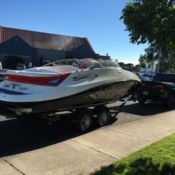 2007 230 Wake Sea Doo
2007 230 Wake Sea Doo
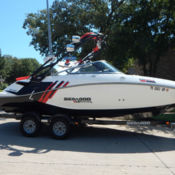 2012 sea doo wake 210 boat
2012 sea doo wake 210 boat
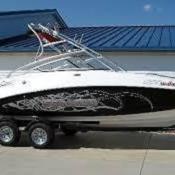 2008 Sea-Doo 230 Wake 430HP!
2008 Sea-Doo 230 Wake 430HP!
 2008 Sea-Doo 230 Wake Edition Used
2008 Sea-Doo 230 Wake Edition Used
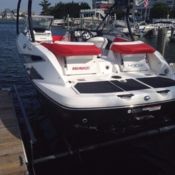 2010 Sea-Doo Wake 210 Jet Boat - MUST GO! - $37500 (Wildwood NJ)
2010 Sea-Doo Wake 210 Jet Boat - MUST GO! - $37500 (Wildwood NJ)
